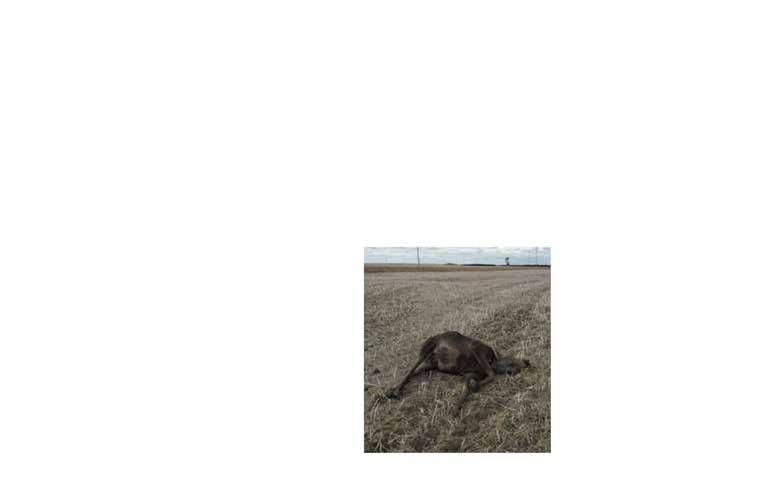
6 minute read
Grazing in Native Prairies
Grazing in Native Prairies: Past Form, Present Function and Future Potential By Shirley Bartz, for the Saskatchewan Prairie Conservation Action Plan
The land that is now the Canadian prairies first become home to grasses fifteen million years ago. With the arrival of grasses came grazers like prehistoric wild horses, camels, rhinoceros, elephants and bison. These grazers lived in the Canadian Prairies at the southern edge of glaciers.
Advertisement
Four times within the last million years glaciers a mile high pressed south and retreated north across the prairies. In the last glacial advance, suitable habitat available to displaced grassland wildlife was drastically reduced, crowding these species into remnants of the Great Plains hundreds of miles south of today’s U.S. border. With reduced suitable habitat, large prairie mammals like rhinoceros, camel and horse died out, but bison survived.
Most of the flora and fauna present in the prairies today evolved under the grazing activity of bison and other large herbivores, as well as periodic fire disturbance. Despite the seeming simplicity of the prairie landscape, the untrained eye misses the complexities of grass communities and the diversity of invertebrates, mammals, birds, amphibians and reptiles that live in a healthy native prairie. This community depends on large ungulate grazers such as bison and cattle to shorten, open and fertilize the plant community, creating a mosaic of grass and forb patches necessary to support species from greater prairie chickens to prairie rattlesnake. When bison were eradicated from the prairies in the late 1800s, maintenance of native grasslands fell largely to the range management practices of ranchers. Under their stewardship, livestock have filled the evolutionary role of grazing herds needed to maintain grassland health and function. Sadly, the rate of agricultural development and area of grassland converted to row-crops has far outstripped the land designated to pasture ranching. When the Department of the Interior created Canada’s first extensive map series in the late 1800s, the Prairie Ecozone was noted as encompassing 140 million acres of native grasslands, with 60 million of those acres in southern Saskatchewan. Since the late 1900s, naturalist societies and conservation groups have been concerned with the impact of development and the resulting loss of native prairie grasslands in Saskatchewan.
Since the turn of the 21st century, a need to understand the rate at which Saskatchewan’s native grasslands are disappearing in SK has produced several studies. In 2001, the Native Plant Society of SK analyzed satellite data from 1995 and estimated that 17-21% of native grassland remained in SK. A study on grassland fragmentation published in 2014 reported 15% remaining grassland cover. Currently, the Ministry of Environment is developing a Prairie Landscape Inventory, which estimates 33.9% of the Mixed Grassland Ecoregion is in native land cover. Though their methods are slightly different, all of these studies point to a steady loss of native grasslands to agricultural and industrial development, urban growth, roads and other human footprints.
Intact native prairie provides a host of ecological services such as carbon sequestration in plant and root biomass, perennial soil stabilization, and habitat for a wildlife community that provides balanced predator-prey relationships and pollinator services.
Wetlands and sloughs are another important part of native grassland function in the prairie pothole area, acting like circulatory and lymphatic systems in the body of the prairie landscape. During high seasonal precipitation, functional wetland networks and associated riparian zones provide collection basins for surface water that reduce overland flooding. These drainage systems are supported by soil hydrology and deep riparian
roots systems that can absorb intense
precipitation, minimize topsoil erosion and reduce sediment load in downstream waterbodies.
Native prairie also provides specific services to livestock producers because it requires minimum input once it is established. Its resilience to a variety of climate conditions makes it a hardy forage resource for grazing. Native prairie is available as forage earlier in the spring than tame grasses and is especially valuable for calf/cow operations in southwestern Saskatchewan.
Changes in ownership and management of grasslands in Saskatchewan, such as the Agricultural Crown Land Sale Program (2008-2014) and the transition of Community Pastures (PF Pastures) from federal to provincial, and then largely to private ownership (20122018) have led to the majority of native grasslands being privately owned and independently managed. In a 2019 article for the Winnipeg Free Press, Tim Sopuck, CEO of the Manitoba Habitat Heritage Corporation observed that “… if we took Canadian beef producers as a single group, raising cattle on native grasslands, woodlands and wetlands, they would constitute the single largest habitat-conservation group in the country. They manage all that wildlife habitat at no charge to the rest of us”.
Wildlife species are not the only population at risk in Saskatchewan’s prairies. As the number of people living and working in rural Saskatchewan decreases, so do the numbers of landowners implementing generations of range management knowledge. Their expertise and understanding of sustainable land and livestock management are of the greatest possible importance to maintaining the ecological function and health of native grasslands in Saskatchewan. The fact that these grasslands support more than 60 different at-risk species, making up close to three quarters of the province’s species at risk, means that these landowners bear a huge burden of government and public scrutiny to care for the species at risk that their land is healthy enough to support. Although the past decade has seen substantial increases in incentive programs to compensate and support ranchers in their stewardship of these lands, the irony of the pressure they feel while struggling to maintain a thriving ranch operation is not lost to any one of them. Neither should it be lost to the public at large.
The Saskatchewan Prairie Conservation Action Plan works with their 30 partners to educate the general public about the importance of the conservation work that landowners are doing to maintain native grasslands and all the creatures that call these ancient prairies home. B
YOU CAN HELP SOLVE THIS CASE AND EARN CASH REWARDS IF THE INFORMATION YOU PROVIDE LEADS TO THE ARREST OR CONVICTION OF THE INDIVIDUAL(S) INVOLVED. (Calls are not traced or recorded and callers can choose to remain anonymous.)
If you have any information regarding this case or other violations: Call the Toll-Free Turn In Poachers & Polluters Line 1-800-667-7561 Call #5555 from a Sasktel Cellphone (no text messages) Report online at www.saskatchewan.ca/tipp
1 S E A C
A Leader Conservation Officer responded to a mature pronghorn antelope buck that was shot, killed, and left to waste sometime between noon on Saturday, April 25th and 10am Sunday, ApApril 26th . The pronghorn was found 5 miles West, 4 miles South and 400m East of Richmound, SK. There was no pronghorn antelope season on at the time.
2 S E A C


















On April 28th , 2020, Estevan Conservation Officers investigated a shot and left pregnant cow moose at SW 18-06-05 W2, approximately 12km Northeast of Lampman, SK. The investigation indicated ththat the moose had likely been shot and wounded on or before Saturday, April 25th , and succumbed to its injuries on Sunday, April 26th . There was no moose season on at the time.








